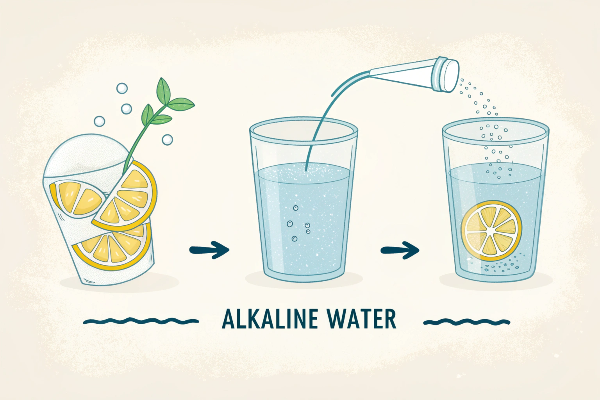High energy costs in nickel electrowinning can really hurt your bottom line. But what if you could significantly cut those costs? Optimizing pH and temperature is a game-changer.
Properly managing pH and temperature during nickel electrowinning directly boosts energy efficiency. This fine-tuning minimizes wasted power on side reactions and ensures optimal conductivity, leading to substantial energy savings and a more cost-effective operation.
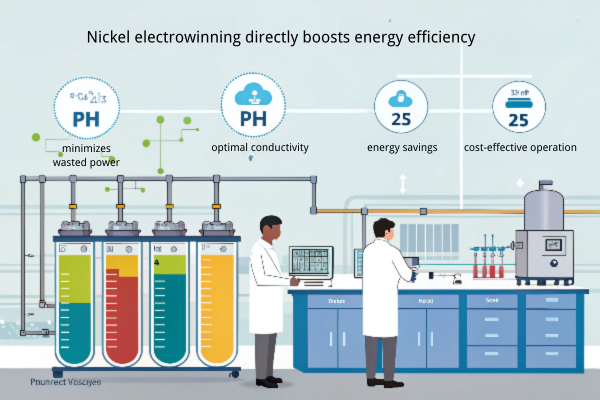
You might be wondering exactly how these parameters wield such influence. Let’s dive into the specifics, because understanding these details is the first step towards unlocking serious savings and improving your nickel quality. I’ve seen firsthand how these adjustments can transform an operation.
How do pH levels affect energy efficiency in nickel electrowinning?
Are your pH levels1 secretly draining your energy budget? An unmanaged pH can lead to inefficient reactions and costly problems. Understanding pH’s role is your first step to control.
The pH level directly impacts reaction speeds and unwanted side reactions. Maintaining an optimal pH, typically between 1.5 and 3.0, prevents energy waste and improves current efficiency, crucial for energy-efficient nickel recovery2.

The Science Behind pH and Energy Use
The pH of your electrolyte solution is more than just a number; it’s a critical controller of electrochemical behavior3. When I first started working with electrowinning processes, the impact of small pH variations on energy consumption was a revelation. If the pH is too low (too acidic), you can see an increase in hydrogen evolution. This is a side reaction where your electrical energy is consumed to produce hydrogen gas instead of depositing nickel. That’s just wasted power.
On the other hand, if the pH gets too high, you risk precipitating metal hydroxides. These can passivate the anode or cathode, meaning they form an inactive layer that increases resistance. More resistance means you need more voltage, and thus more energy, to drive the desired nickel deposition. The ideal pH window4, generally 1.5 to 3.0, is a sweet spot. It minimizes these parasitic reactions and keeps the nickel ions readily available for deposition. We also found that a very stable pH, controlled by online monitoring systems5 coupled with automatic acid/base dosing6, prevents swings that can average out to higher energy use over time. For instance, precise control to keep pH within ±0.1 of the setpoint, say 2.0, can lead to noticeable energy improvements compared to a wider fluctuation.
| pH Level | Hydrogen Evolution | Nickel Deposition Rate | Overall Energy Efficiency | Potential Issues |
|---|---|---|---|---|
| < 1.5 | High | Potentially Reduced | Low | Excessive gassing, acid mist |
| 1.5 – 3.0 | Optimal (Low) | Optimal | High | Ideal operating range |
| > 3.0 | Low | Can Decrease | Moderate to Low | Hydroxide precipitation, passivation |
Achieving this control isn’t just about occasional checks; it often requires online pH sensors and automated titration systems to maintain stability. This kind of precise control is key to unlocking those energy savings.
What is the ideal temperature range for low-energy nickel electrodeposition?
Is your process too hot, burning energy, or too cold, slowing things down? Incorrect temperatures can be a silent profit killer. Finding that temperature sweet spot is essential for efficiency.
The ideal temperature for energy-efficient nickel electrodeposition7 usually falls between 55-65°C. This range balances faster reaction kinetics and good conductivity with manageable heating costs, preventing excessive energy use for maintaining higher temperatures.
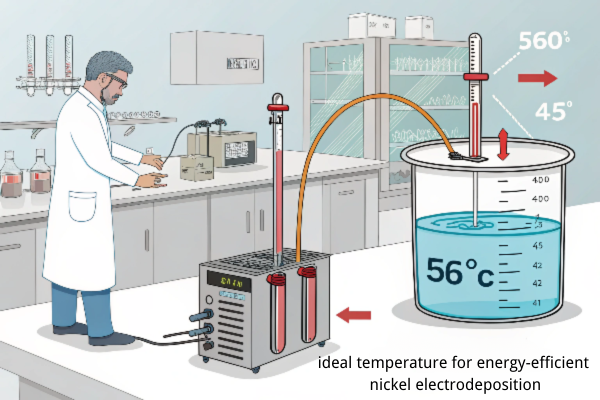
Finding the Temperature Sweet Spot
Temperature plays a crucial role in the speed and efficiency of the electrowinning process. Think of it like this: higher temperatures generally make chemical reactions happen faster, and this includes the deposition of nickel. The electrolyte’s conductivity also improves with temperature, which means less electrical resistance and potentially lower voltage for the same current. So, cranking up the heat might seem like a good idea for throughput.
However, maintaining high temperatures costs a lot of energy. There’s also a point of diminishing returns, and even potential downsides, like increased evaporation or faster degradation of tank components. My experience has shown that the 55-65°C (approximately 130-150°F) range is often the sweet spot. In this range, we achieve a good deposition rate without incurring excessive heating costs. It’s a compromise. Below this, the kinetics can be sluggish, leading to lower current efficiency. Above it, the energy needed to maintain the temperature can outweigh the kinetic benefits. Implementing heat recovery systems8, like heat exchangers that use the heat from outgoing spent electrolyte to warm incoming fresh electrolyte, is a smart move. Also, precise, closed-loop temperature control system9s are vital to avoid fluctuations that can negatively impact both energy use and deposit quality. A stable temperature ensures a consistent process.
| Temperature (°C) | Deposition Rate | Electrolyte Conductivity | Heating Energy Cost | Overall Energy Efficiency |
|---|---|---|---|---|
| < 50 | Slower | Lower | Lower | Sub-optimal |
| 55 – 65 | Good | Good | Moderate | Optimal |
| > 70 | Faster | Higher | High | Can Decrease (net) |
One plant I visited was running at 75°C, thinking faster was always better. After analysis, we brought it down to 60°C, added some insulation, and they saw a significant drop in their steam consumption with minimal impact on their daily nickel output.
How to reduce energy consumption in nickel electrowinning plants?
Are you still battling high energy bills despite some optimizations? Focusing only on individual parameters like pH or temperature might not be enough. A holistic strategy often yields the best results.
To truly cut energy use, adopt a comprehensive strategy. This involves optimizing pH and temperature together, but also current density10, and considering technologies like pulse plating11. This synergistic approach can yield significant overall energy savings.

A Multi-Factor Approach to Energy Savings
Reducing energy consumption in a nickel electrowinning plant isn’t just about tweaking one or two knobs. It’s about looking at the entire system. While pH and temperature are foundational, other factors like current density, electrode design, and even the use of specific additives play significant roles. I’ve had success implementing what I call a "synergistic optimization model12." This approach doesn’t just look at parameters in isolation but considers their interactions.
For example, we might aim for a pH around 2.0-2.5 and a temperature of 60°C. Then, we adjust the current density. Too high a current density can lead to inefficiencies and poor deposit quality, even if pH and temp are optimal. A range of 200-250 A/m² is often a good target for many nickel sulfate electrolytes. Beyond these, incorporating advanced techniques like pulse plating can be very effective. Instead of a constant DC current, pulse plating uses cycles of on-off or varying current. This can improve deposit structure, reduce internal stress, and enhance current efficiency, all contributing to lower energy use. When these elements are combined, the savings can be substantial. I’ve seen plants achieve 30-40% energy savings by moving from a loosely controlled, traditional setup to a well-monitored, synergistically optimized one. This also often leads to better cathode quality, which is an added bonus.
| Parameter | Traditional Setting | Optimized Setting (Synergistic) | Energy Impact |
|---|---|---|---|
| pH | 1.0 – 3.5 (variable) | 2.0 – 2.5 (stable) | Reduced side reactions |
| Temperature | 50 – 70°C (variable) | 60°C (stable) | Optimal kinetics/cost |
| Current Density | 250 – 350 A/m² | 200 – 250 A/m² | Improved efficiency |
| Plating Mode | Constant DC | Pulse Plating (optional) | Enhanced deposition |
Sustainable nickel refining isn’t a distant dream; it’s achievable with these integrated approaches.
Can pH and temperature adjustments improve nickel purity and lower costs?
Are you worried that saving energy might mean sacrificing the quality of your nickel? It’s a common concern, but you can achieve high purity alongside lower operational costs.
Yes, carefully adjusting pH and temperature can significantly improve nickel purity13 by minimizing the co-deposition of impurities14 like iron and copper. This not only yields a higher-value product but also reduces overall costs by optimizing metal recovery.
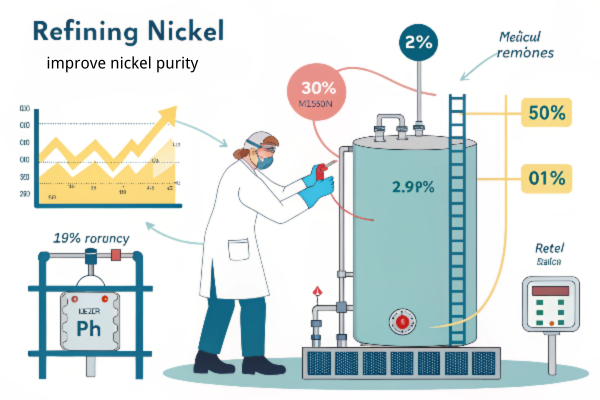
Balancing Purity, Cost, and Energy
One of the most satisfying outcomes of optimizing electrowinning parameters is seeing an improvement in nickel purity while simultaneously cutting costs. It might seem counterintuitive to some – surely pushing for higher purity costs more? Not necessarily, if you’re smart about it. The key lies in how pH and temperature affect not just nickel deposition, but also the behavior of common impurities like iron (Fe) and copper (Cu).
For instance, maintaining the pH in a slightly higher range within the optimal window, say above pH 2.5 but still below 3.0, can help suppress the co-deposition of iron. Iron tends to precipitate out as ferric hydroxide at higher pH values, meaning less of it ends up in your cathode. Similarly, precise temperature control affects the relative deposition rates of nickel versus these impurities. My team once worked on a project where the client was struggling with iron contamination. By carefully raising the operating pH from 1.8 to 2.6 and stabilizing the temperature at 60°C, we saw a remarkable drop in iron content in the final nickel. Analytical results using SEM-EDS (Scanning Electron Microscopy with Energy Dispersive X-ray Spectroscopy) confirmed this. Before optimization, their purity was around 99.7%; afterwards, they consistently achieved 99.92% or higher. This not only increased the value of their product but also reduced downstream refining needs for certain applications, effectively lowering overall production costs.
| Parameter Setting | Iron (Fe) Co-deposition | Copper (Cu) Co-deposition | Nickel Purity | Overall Cost Impact |
|---|---|---|---|---|
| Low pH (<2.0), Unstable Temp | Higher | Moderate | Lower | Higher |
| Optimal pH (>2.5), Stable Temp (55-65°C) | Significantly Lower | Lower | Higher (e.g., >99.9%) | Lower |
| High pH (>3.5) | Lower (but risk of Ni(OH)₂) | Lower | Variable | Can increase due to Ni loss |
This shows that optimizing for energy efficiency15 can go hand-in-hand with producing high-purity, cost-effective metal.
What sensors are best for monitoring pH and temperature in electrowinning?
Are you relying on manual checks or outdated sensors for your critical pH and temperature data? Inaccurate or delayed data can lead to an inefficient and costly process. Investing in the right sensors is crucial.
For reliable monitoring, corrosion-resistant pH sensors16 like antimony electrodes17, and accurate temperature probes such as PT1000 RTDs18, are best. These provide the stable, real-time data needed for process optimization and control.
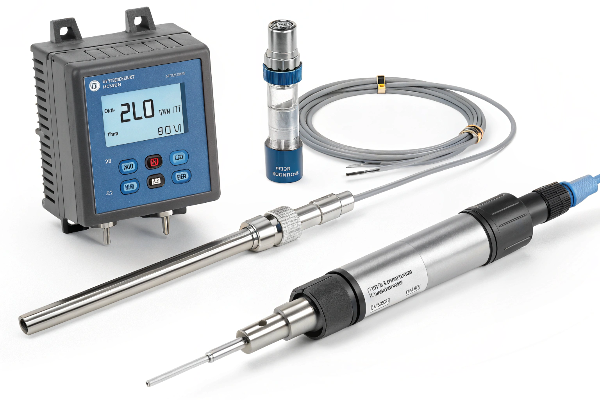
Choosing the Right Eyes and Ears for Your Process
To effectively control pH and temperature for energy efficiency and product quality, you need reliable, real-time data. This is where choosing the right sensors becomes critical. In the harsh chemical environment of an electrowinning tankhouse, not just any sensor will do. I’ve learned over the years that robustness and accuracy are paramount, along with ease of maintenance.
For pH measurement, traditional glass electrodes can be fragile and susceptible to fouling or breakage. In many nickel electrowinning solutions, especially those with fluorides or high solids, an antimony electrode pH sensor is often a better choice. They are more robust and resistant to chemical attack, offering a longer service life despite potentially being a bit less accurate than a perfectly calibrated glass electrode in ideal conditions. Their durability often outweighs the slight precision trade-off in an industrial setting.
For temperature, Platinum Resistance Temperature Detectors (RTDs), specifically the PT1000 type, are excellent. PT1000 sensors offer high accuracy and stability over a wide temperature range and are quite resilient. They are preferred over thermocouples in applications where higher precision is needed.
Integrating these sensors into an IoT (Internet of Things) platform can take your monitoring to the next level. Imagine getting remote alerts if your pH fluctuates by more than 0.2 units, or if a tank temperature drifts. Some systems can even trigger automated adjustments to acid dosing pumps or steam valves. This proactive control, driven by good sensor data, is key to maintaining optimal conditions consistently. For example, one facility I consulted for linked their pH sensors to an automated acid dosing system. This immediately stabilized their pH, reducing swings and leading to a 5% drop in specific energy consumption for that section. When considering sensors, it’s worth looking at technical documentation from reputable suppliers to understand their suitability for your specific electrolyte composition and operating conditions.
| Sensor Type | Parameter | Pros | Cons | Recommended for Nickel Electrowinning? |
|---|---|---|---|---|
| Glass Electrode | pH | High accuracy (when clean & calibrated) | Fragile, susceptible to fouling/breakage | With caution, high maintenance |
| Antimony Electrode | pH | Robust, corrosion-resistant | Slightly less accurate than glass | Often Recommended |
| Thermocouple | Temperature | Wide range, inexpensive | Less accurate than RTDs | For less critical monitoring |
| PT1000 RTD | Temperature | High accuracy, stable, good resistance | More expensive than thermocouples | Highly Recommended |
Investing in the right "eyes and ears" for your process is a direct investment in efficiency and profitability.
Conclusion
Optimizing pH and temperature, backed by reliable sensors and a holistic view, is key. This leads to energy savings, better nickel purity, and lower overall operational costs.
-
Exploring this link will deepen your understanding of how pH levels can optimize energy efficiency in nickel recovery processes. ↩
-
This resource will provide insights into best practices that enhance energy efficiency in nickel recovery, crucial for cost savings. ↩
-
Understanding electrochemical behavior is key to improving nickel electrowinning processes and reducing energy waste. ↩
-
Understanding the ideal pH window can help optimize nickel deposition processes and improve energy efficiency. ↩
-
Exploring this resource will reveal how technology enhances pH control, leading to better energy efficiency in nickel deposition. ↩
-
Learn how automatic dosing systems can maintain optimal pH levels, reducing energy consumption and improving deposition rates. ↩
-
Understanding nickel electrodeposition is crucial for optimizing energy efficiency and improving production processes. Explore this link for in-depth insights. ↩
-
Heat recovery systems can reduce energy costs and improve efficiency in nickel electrodeposition. Learn how they function and their advantages. ↩
-
A well-designed temperature control system can significantly enhance the efficiency of electrowinning processes. Discover more about its benefits here. ↩
-
Discover the importance of current density in nickel electrowinning and how it affects energy efficiency and deposit quality. ↩
-
Learn how pulse plating can significantly reduce energy consumption and improve deposit quality in nickel electrowinning processes. ↩
-
Explore this resource to understand how a synergistic optimization model can enhance energy efficiency in nickel electrowinning plants. ↩
-
Explore this link to understand the techniques for enhancing nickel purity while reducing costs, ensuring high-quality production. ↩
-
Learn about co-deposition and its impact on nickel quality, and discover methods to minimize impurities for better results. ↩
-
Investigate the relationship between energy efficiency and nickel production to find ways to optimize costs without sacrificing quality. ↩
-
Discover the top corrosion-resistant pH sensors that ensure reliable data in challenging industrial environments. ↩
-
Explore the advantages of antimony electrodes for pH measurement, especially in harsh environments like electrowinning. ↩
-
Learn why PT1000 RTDs are favored for their accuracy and stability in temperature monitoring, crucial for process control. ↩



